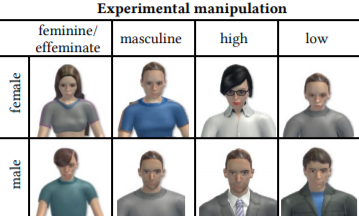Being Touched by a Virtual Human.: Relationships Between Heart Rate, Gender, Social Status, and Compliance.
PubDate: July 2019
Teams: University of Barcelona,Polish Academy of Sciences
Writers: Justyna Swidrak;Grzegorz Pochwatko

Abstract
Interpersonal touch remains one of the most puzzling and challenging aspects of communication in virtual reality. A brief touch can be used to influence one’s behavior. Our study aimed to analyze the influence of an agent’s touch on men’s compliance and its psychophysiological correlates. Additionally, we asked whether social cues such as aspect, stereotypically related to masculinity/femininity and social status, modify that effectiveness. To answer these questions, we built an immersive version of the classic decision-making game Ultimatum in which a proposer offers how to split 10 coins and a responder decides whether to accept it or not. In our experiment, we used the game to observe whether men are more compliant to the agent if the offer was preceded by a touch, compared to two control conditions: no stimulus and a buzz. In two experiments, male participants played with four agents each, differing in gender and levels of stereotypically seen masculinity (study 1) and social status (study 2). Before the proposer made an offer, he/she could take additional action, namely, to send a sound (short buzz) or touch the participant. The key factor in securing compliance was the value of the offer made by the agent - the more generous the offer, the higher the chances for its acceptance. Surprisingly, even though the manipulation of the agent’s characteristics was successful in both studies, neither touch nor the agent’s gender influenced compliance in men. Additionally, the perceived level of the agent’s social status slightly increased the chances of the offer being accepted. We registered a heart-rate deceleration in study 1 as a reaction to the agent’s touch, which nevertheless did not affect participant’s economic decisions. The results are discussed in the context of social characteristics important in agent design and the effectiveness of social influence techniques in virtual reality.


